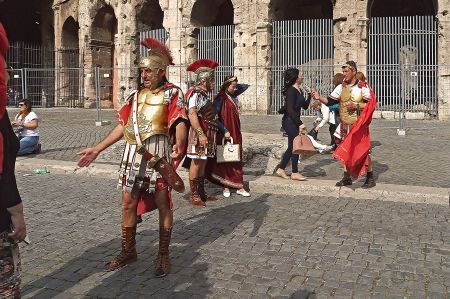The Roman Kinzigtal Road and its forts
- Written by Portal Editor
In their policy of expansion across the Alps, the Rhine and the Danube initially formed the borders of the Roman Empire, which created a major kink in the border line through the Rhine.
This meant long distances for Roman soldiers and thus loss of time in case of danger and, of course, large detours for trade. As a result, the Romans advanced further along the Rhine and Danube in the first and second centuries and built forts and other fortifications. The most important goal for the Romans at this time was to shorten the strategically important connection between Mainz and Augsburg, which was previously only possible along the bend in the Rhine via Basel. This detour had already emerged as a major problem during the Batavi rebellion in AD 69 and 70.
Forts and camps were built parallel to the construction of the military road
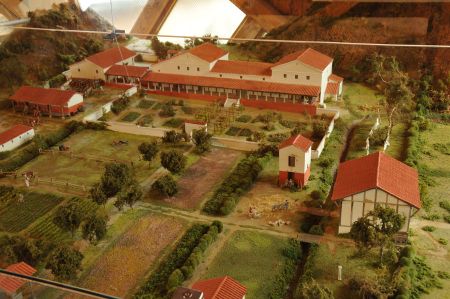 During their advance, Roman troops also came across the Kinzig valley, whose width, length and favorable course in an east-west direction were ideal for building a road. Initial thoughts quickly turned into a project that was of course primarily assigned to military purposes: a military road that crossed the valley and was intended to significantly shorten the route from Mogontiacum (Mainz) via Argentoratum (Strasbourg) to Augusta Vindelicorum (Augsburg). The reigning Roman emperor Vespasian immediately took up the idea, and as early as 73 AD work began on the construction of the military road from modern Offenburg through the Kinzig valley to Arae Flaviae (Rottweil), which was founded at the same time, and on to Tuttlingen. The road was completed just a year later.
During their advance, Roman troops also came across the Kinzig valley, whose width, length and favorable course in an east-west direction were ideal for building a road. Initial thoughts quickly turned into a project that was of course primarily assigned to military purposes: a military road that crossed the valley and was intended to significantly shorten the route from Mogontiacum (Mainz) via Argentoratum (Strasbourg) to Augusta Vindelicorum (Augsburg). The reigning Roman emperor Vespasian immediately took up the idea, and as early as 73 AD work began on the construction of the military road from modern Offenburg through the Kinzig valley to Arae Flaviae (Rottweil), which was founded at the same time, and on to Tuttlingen. The road was completed just a year later.
Parallel to the construction of the military road, forts and camps were built to fortify the new border line. In addition to Rottweil, a military camp was set up in Offenburg-Rammersweier, one in Offenburg-Zunsweier, the fort in Waldmössingen, the fort in Sulz, a camp in Geislingen-Häsenbühl and the forts in Frittlingen, Lautlingen and Burladingen, although the latter three also served to secure the Alblimes. With the exception of the Burladingen military camp, which was located on Rhaetian territory, all other camps and forts were built on Upper German territory.
The distance between the forts in Offenburg and Waldmössingen is too big
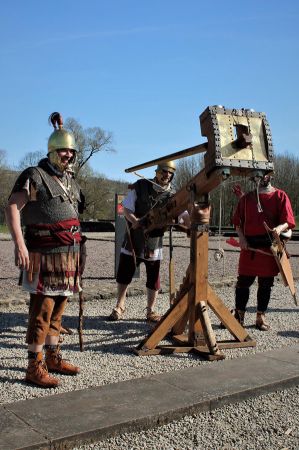 In 1975, the remains of a foundation belonging to the corner tower of a Roman fort were found near the village of Waldmössingen. A few years later, the foundation walls and parts of the adjoining wall were rebuilt. Here, too, the age of the building at the time when the Kinzigtalstraße was built is evident.
In 1975, the remains of a foundation belonging to the corner tower of a Roman fort were found near the village of Waldmössingen. A few years later, the foundation walls and parts of the adjoining wall were rebuilt. Here, too, the age of the building at the time when the Kinzigtalstraße was built is evident.
When the fort in Frittlingen, which is only a few kilometers south-east of Rottweil, was surprisingly discovered in 1992, people were sure that there must have been other forts to protect the Kinzigtalstraße. There were always exactly certain maximum distances for fortifying the borders in the Roman Empire. Archaeologists now assume that there must have been at least one other fort in the Kinzig valley. Since the distance between the forts at Offenburg and Waldmössingen is too great to ensure a secure border, one or two other forts are believed to have remained undiscovered. There are similar assumptions in Rottenburg, where a Roman fort has not yet been found.
The connection between Augsburg and Mainz was further shortened by this expansion
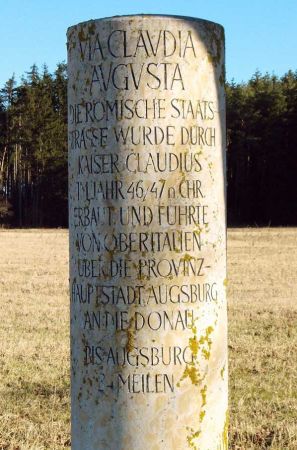 Castles were built in the same way almost everywhere in Roman territory. Often they were initially surrounded by a construction of wood and earth in the form of a wall, which was later replaced by stone walls. A wide and deep camp ditch usually ran along the walls, with a defensive ring road between the ditch and the wall. Even before the walls were built, the two camp streets running at right angles to each other had been set up. There were always four exit gates, which were usually protected by stronger towers. At the intersection of these two streets, i.e. in the middle of the camp, stood the staff building, the command center of the camp commandant and his accommodation.
Castles were built in the same way almost everywhere in Roman territory. Often they were initially surrounded by a construction of wood and earth in the form of a wall, which was later replaced by stone walls. A wide and deep camp ditch usually ran along the walls, with a defensive ring road between the ditch and the wall. Even before the walls were built, the two camp streets running at right angles to each other had been set up. There were always four exit gates, which were usually protected by stronger towers. At the intersection of these two streets, i.e. in the middle of the camp, stood the staff building, the command center of the camp commandant and his accommodation.
Most of the time, right here in the center of the camp, there was also a flag shrine with a picture of the emperor and a hospital, of which there was one for people and one for horses. The workshops of the blacksmith, armorer and carpenter needed for the camp were also located in the center. This core was surrounded by the crew barracks, supply stores and horse stables in a precise military arrangement. As a rule, up to 6,000 men and 120 horsemen were housed in forts like this one.
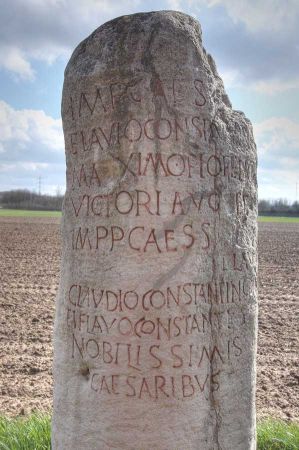 Due to the further advance of the Roman troops, further fortifications were built just a little later north of the Kinzigtalstraße, all of which are located east of the Rhine, for example in Frankfurt-Heddernheim, Okarben, Groß-Gerau and Ladenburg (Lopodunum). It is still unclear to the researchers whether these camps were initially just outposts or whether the course of the border line of the Roman Empire had already shifted that far between 73 and 98 AD. Such outposts have also been found in Gernsheim, Heidelberg and Baden-Baden (Aquae). It is assumed today that from about the year 98 the entire area of south-west Germany from the Odenwald to the Neckar was under Roman rule. The connection between Augsburg and Mainz, which was so important for the Romans, was further shortened by this expansion, which meant that the Kinzigtalstraße almost completely lost its importance as a military road.
Due to the further advance of the Roman troops, further fortifications were built just a little later north of the Kinzigtalstraße, all of which are located east of the Rhine, for example in Frankfurt-Heddernheim, Okarben, Groß-Gerau and Ladenburg (Lopodunum). It is still unclear to the researchers whether these camps were initially just outposts or whether the course of the border line of the Roman Empire had already shifted that far between 73 and 98 AD. Such outposts have also been found in Gernsheim, Heidelberg and Baden-Baden (Aquae). It is assumed today that from about the year 98 the entire area of south-west Germany from the Odenwald to the Neckar was under Roman rule. The connection between Augsburg and Mainz, which was so important for the Romans, was further shortened by this expansion, which meant that the Kinzigtalstraße almost completely lost its importance as a military road.
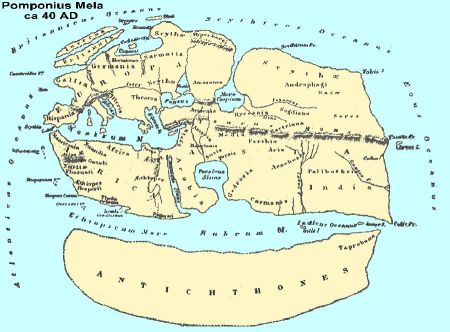 For trade, however, the Kinzigtalstraße continued to be of great national importance. Wherever the landscape permitted, the Romans built their roads dead straight. Usually between 4 and 5 meters wide, the road surfaces were mostly covered with gravel, sometimes also paved. There were ditches for rainwater to the right and left of the road. Merchants liked to use the Roman road systems with their beasts of burden or carts, as they ensured fast progress and safe routes. Due to the good supply of rest stops along the route, express couriers were able to cover about 200 kilometers per day, a coach needed about 10 days for the route from Mainz to Rome. Roman milestones were erected at important road points and provided information about distances and who built the road. The discovery of a Roman milestone near Offenburg made it clear that the Kinzigtalstraße had been built under Emperor Vespasian by a Roman named Cornelius Clemens.
For trade, however, the Kinzigtalstraße continued to be of great national importance. Wherever the landscape permitted, the Romans built their roads dead straight. Usually between 4 and 5 meters wide, the road surfaces were mostly covered with gravel, sometimes also paved. There were ditches for rainwater to the right and left of the road. Merchants liked to use the Roman road systems with their beasts of burden or carts, as they ensured fast progress and safe routes. Due to the good supply of rest stops along the route, express couriers were able to cover about 200 kilometers per day, a coach needed about 10 days for the route from Mainz to Rome. Roman milestones were erected at important road points and provided information about distances and who built the road. The discovery of a Roman milestone near Offenburg made it clear that the Kinzigtalstraße had been built under Emperor Vespasian by a Roman named Cornelius Clemens.
Please read as well:
